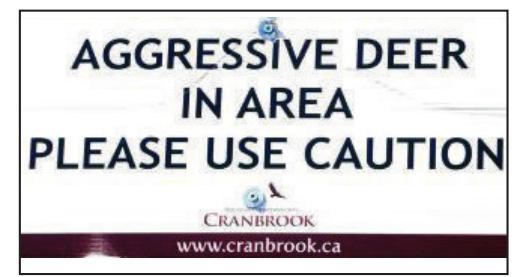Oh deer!
Several signs have been placed throughout the City of Cranbrook, in southeastern sa国际传媒, that may at first appear a little out of the ordinary.
"Aggressive deer in area. Please use caution," the advisory warns in bold capital letters.
Mule deer have been blamed for significant property damage and for attacks on pets. Many of the problem areas are greenspaces near schools, which adds to concern that children could be attacked.
But the signs are also a symbol of the divide between those worried about safety and gardens and those who say a city cull not only isn't working, it's killing the wrong deer.
Last November, Cranbrook culled 25 deer, 11 of them whitetail and 14 mule. It was the first of three Kootenay communities, along with Kimberley and Invermere, to carry out a cull with a licence from the sa国际传媒 Ministry of Forests, Lands and Natural Resource Operations.
"The general feeling from the public was it was a real issue, public safety was sort of No. 1 as well as yard and garden damage. People were having their gardens destroyed," explained Chris Zettel, corporate communications officer for the City of Cranbrook.
But the move has not been without criticism and animal welfare is always an emotional issue, he said.
"With deer we kind of commonly refer to it around here as the Bambi syndrome. People have this sort of Disney view," said Zettel.
"If you're that type of person and you're walking down the street with your dog and a doe comes out of the bushes and stomps your dog or kills your dog, you might change your mind quite quickly."
The initial pilot project didn't go as smoothly as hoped. The mule deer were considered the problem but the traps had snagged almost as many whitetail deer, wrote Dave Dunbar, head of Fish and Wildlife Section in the KootenayBoundary Region, for Forests, Lands and Natural Resources.
"I'm somewhat disappointed at the number of whitetail deer the contractor is killing. Clearly, whitetail deer are not the priority in Cranbrook," Dunbar wrote in an email to the city obtained under the Freedom of Information Act by the Earth Animal Rescue Society.
"I am disappointed to see the primary goals of the Cranbrook Urban Deer Committee stray so far from the target. We may find that the concern for 'Human Safety' might not be improved."
Wildlife biologist Irene Teske also expressed her concerns in a December 2011 email.
"The only reason we included whitetailed deer in the permit from the Minis-ter was in case a few were caught incidentally. I suggest that any other whitetailed deer captured in the traps be released if it is safe to do so."
Zettel acknowledged that in the last year the city has been on a learning curve.
Cranbrook council has approved another cull to remove up to 50 mule deer that was supposed to begin this fall.
But a legal challenge of a similar cull in Invermere is now before the sa国际传媒
Supreme Court and that may prompt Cranbrook to put its cull on hold.
"I think there's an appetite here perhaps to maybe stand back and wait and see what happens with the court case involving Invermere," said Zettel.
"If this report comes back and says the process is good and they can continue fine. But if it's a flawed process and we need to change things - if we have to wait a year or two, then that's what we would have to do, but again that's up to council to make that decision," he said.
The founder and chairman of Humane Treatment of Urban Wildlife agrees that the high number of deer in Cranbrook is a problem but said a cull is not the answer.
"The deer count numbers from March 2012, which show an increase, demonstrate why the 2011 cull did not work so I don't understand why we're still stuck pursuing this," said Colleen Bailey.
Bailey, who is a member of the Cranbrook Urban Deer Committee, said other options could have included relocation, higher fences to protect gardens and yards and finding ways of keeping the deer outside the city.
"All the cull is doing is creating a perpetual cycle of killing."
The contractor captures the deer in clover traps, a netted cage that collapses on top of the animal. He then uses a bolt gun that is placed to the head to kill the deer.
Bailey said that is anything but humane.
"One gun usually doesn't do it and the deer still isn't technically dead," she said.
"So the contractors have to take the deer, throw it in the back of the truck and slit its throat to bleed it out. People are horrified by that."



